Foundations of Management: Adapting to Environmental Change Report
VerifiedAdded on 2022/02/21
|15
|3187
|35
Report
AI Summary
This report examines how organizations, particularly in the retail sector, manage their structure and design in response to environmental changes. It begins with an introduction to organizational transitions and the impact of the environment on employee behavior. The background section focuses on Tesco, Asda, and Morrisons, highlighting their market positions and the influence of internal and external factors. A literature review explores the effects of organizational environments on design, strategy concepts, and the importance of adapting to change. The discussion delves into the factors influencing these retail giants, including technology, politics, and laws, and how they shape organizational structures. The report analyzes the strategies of Tesco, Asda, and Morrisons in adapting to technological advancements and market shifts, including online grocery shopping and the use of data mining and artificial intelligence. The report concludes with a summary of key findings and recommendations for future strategies.
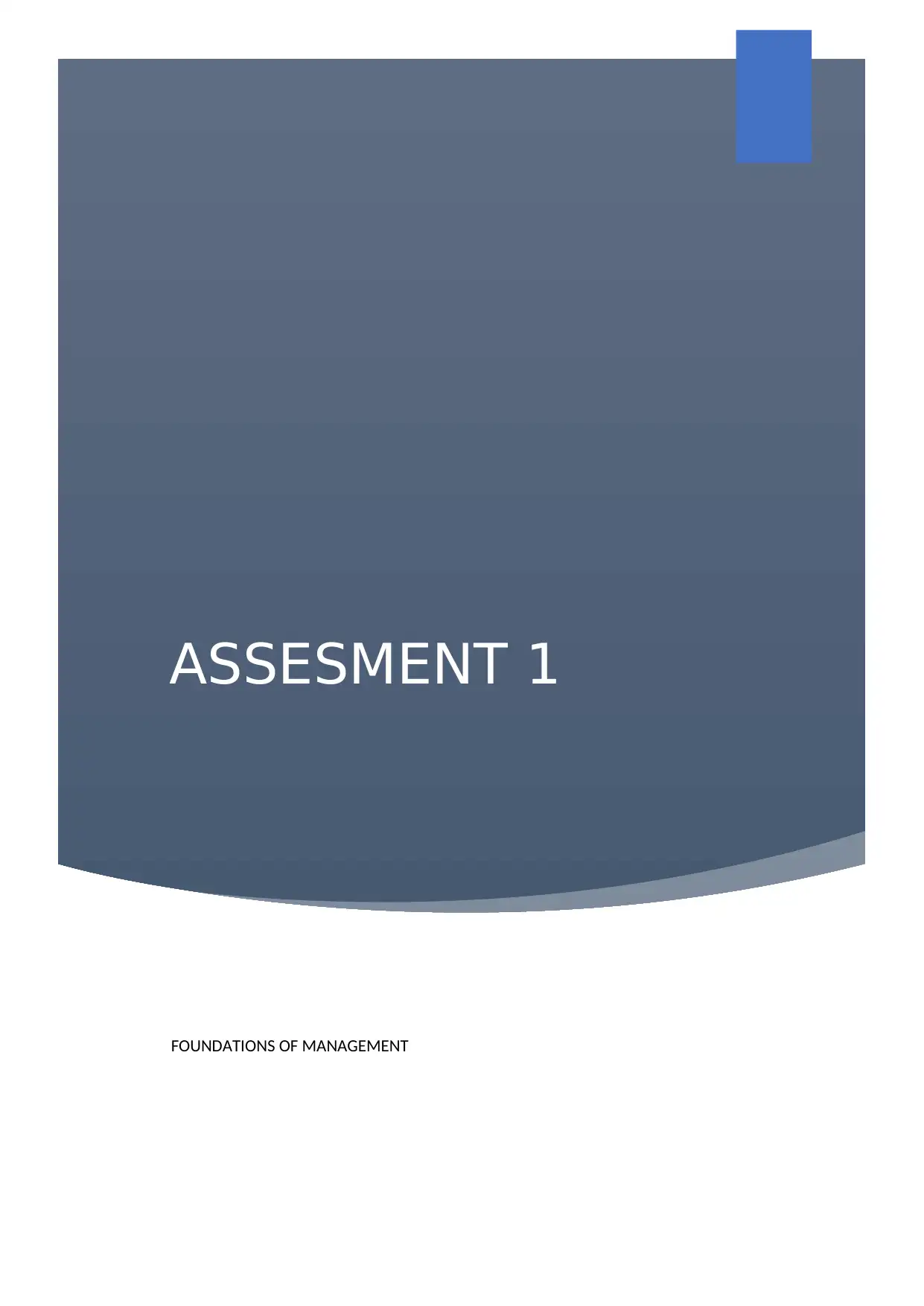
ASSESMENT 1
FOUNDATIONS OF MANAGEMENT
FOUNDATIONS OF MANAGEMENT
Paraphrase This Document
Need a fresh take? Get an instant paraphrase of this document with our AI Paraphraser
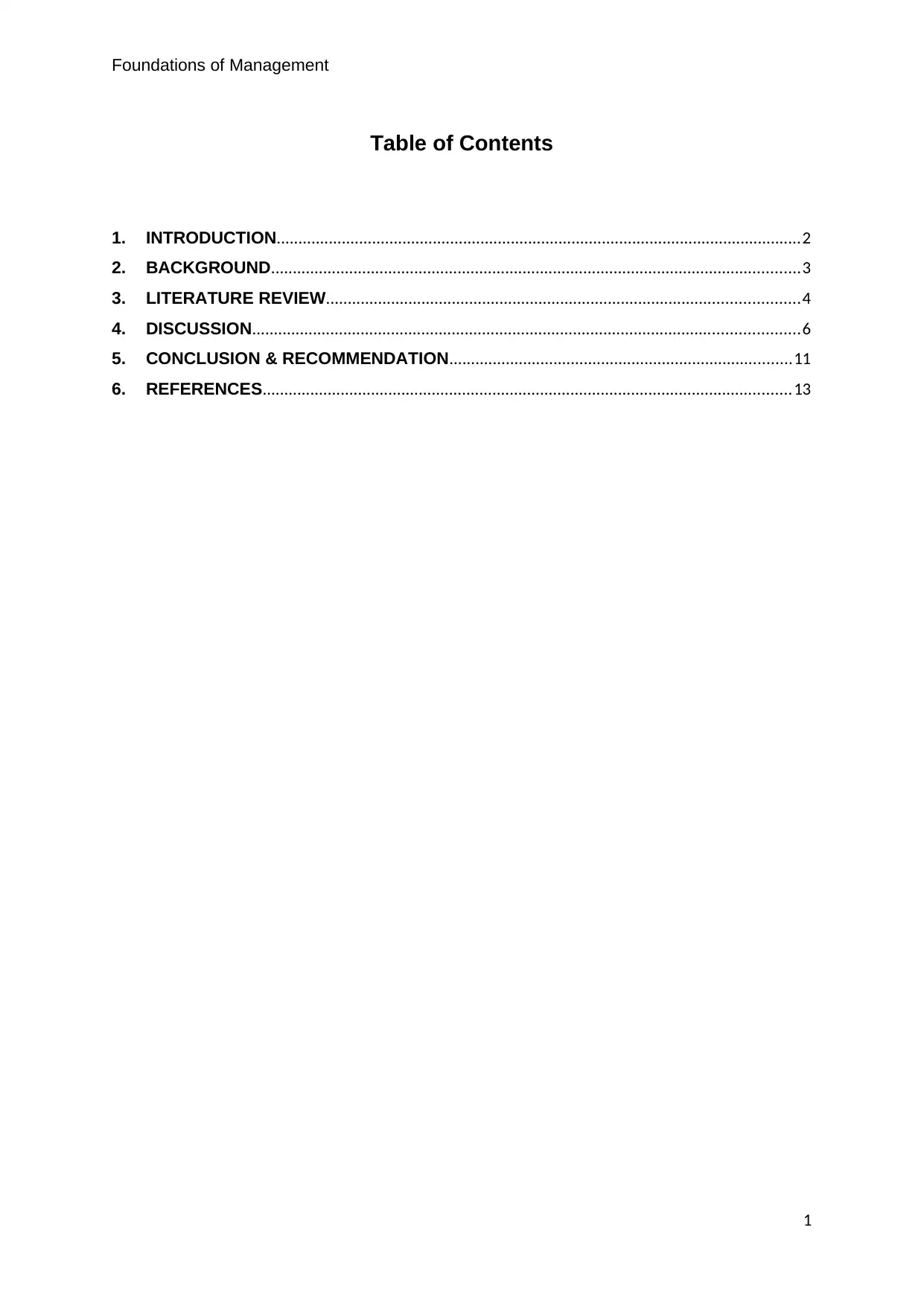
Foundations of Management
Table of Contents
1. INTRODUCTION.........................................................................................................................2
2. BACKGROUND..........................................................................................................................3
3. LITERATURE REVIEW.............................................................................................................4
4. DISCUSSION..............................................................................................................................6
5. CONCLUSION & RECOMMENDATION...............................................................................11
6. REFERENCES..........................................................................................................................13
1
Table of Contents
1. INTRODUCTION.........................................................................................................................2
2. BACKGROUND..........................................................................................................................3
3. LITERATURE REVIEW.............................................................................................................4
4. DISCUSSION..............................................................................................................................6
5. CONCLUSION & RECOMMENDATION...............................................................................11
6. REFERENCES..........................................................................................................................13
1
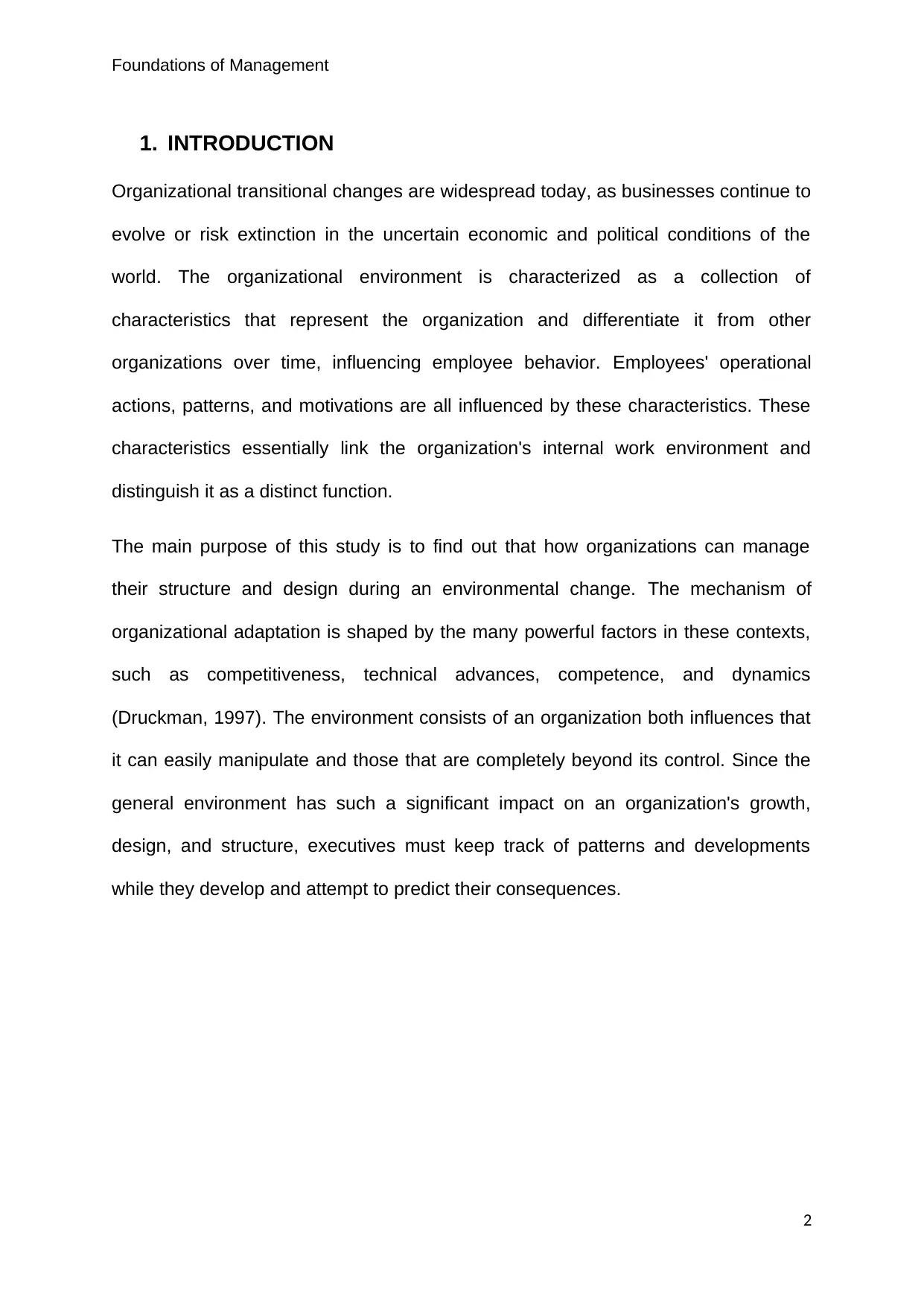
Foundations of Management
1. INTRODUCTION
Organizational transitional changes are widespread today, as businesses continue to
evolve or risk extinction in the uncertain economic and political conditions of the
world. The organizational environment is characterized as a collection of
characteristics that represent the organization and differentiate it from other
organizations over time, influencing employee behavior. Employees' operational
actions, patterns, and motivations are all influenced by these characteristics. These
characteristics essentially link the organization's internal work environment and
distinguish it as a distinct function.
The main purpose of this study is to find out that how organizations can manage
their structure and design during an environmental change. The mechanism of
organizational adaptation is shaped by the many powerful factors in these contexts,
such as competitiveness, technical advances, competence, and dynamics
(Druckman, 1997). The environment consists of an organization both influences that
it can easily manipulate and those that are completely beyond its control. Since the
general environment has such a significant impact on an organization's growth,
design, and structure, executives must keep track of patterns and developments
while they develop and attempt to predict their consequences.
2
1. INTRODUCTION
Organizational transitional changes are widespread today, as businesses continue to
evolve or risk extinction in the uncertain economic and political conditions of the
world. The organizational environment is characterized as a collection of
characteristics that represent the organization and differentiate it from other
organizations over time, influencing employee behavior. Employees' operational
actions, patterns, and motivations are all influenced by these characteristics. These
characteristics essentially link the organization's internal work environment and
distinguish it as a distinct function.
The main purpose of this study is to find out that how organizations can manage
their structure and design during an environmental change. The mechanism of
organizational adaptation is shaped by the many powerful factors in these contexts,
such as competitiveness, technical advances, competence, and dynamics
(Druckman, 1997). The environment consists of an organization both influences that
it can easily manipulate and those that are completely beyond its control. Since the
general environment has such a significant impact on an organization's growth,
design, and structure, executives must keep track of patterns and developments
while they develop and attempt to predict their consequences.
2
⊘ This is a preview!⊘
Do you want full access?
Subscribe today to unlock all pages.

Trusted by 1+ million students worldwide
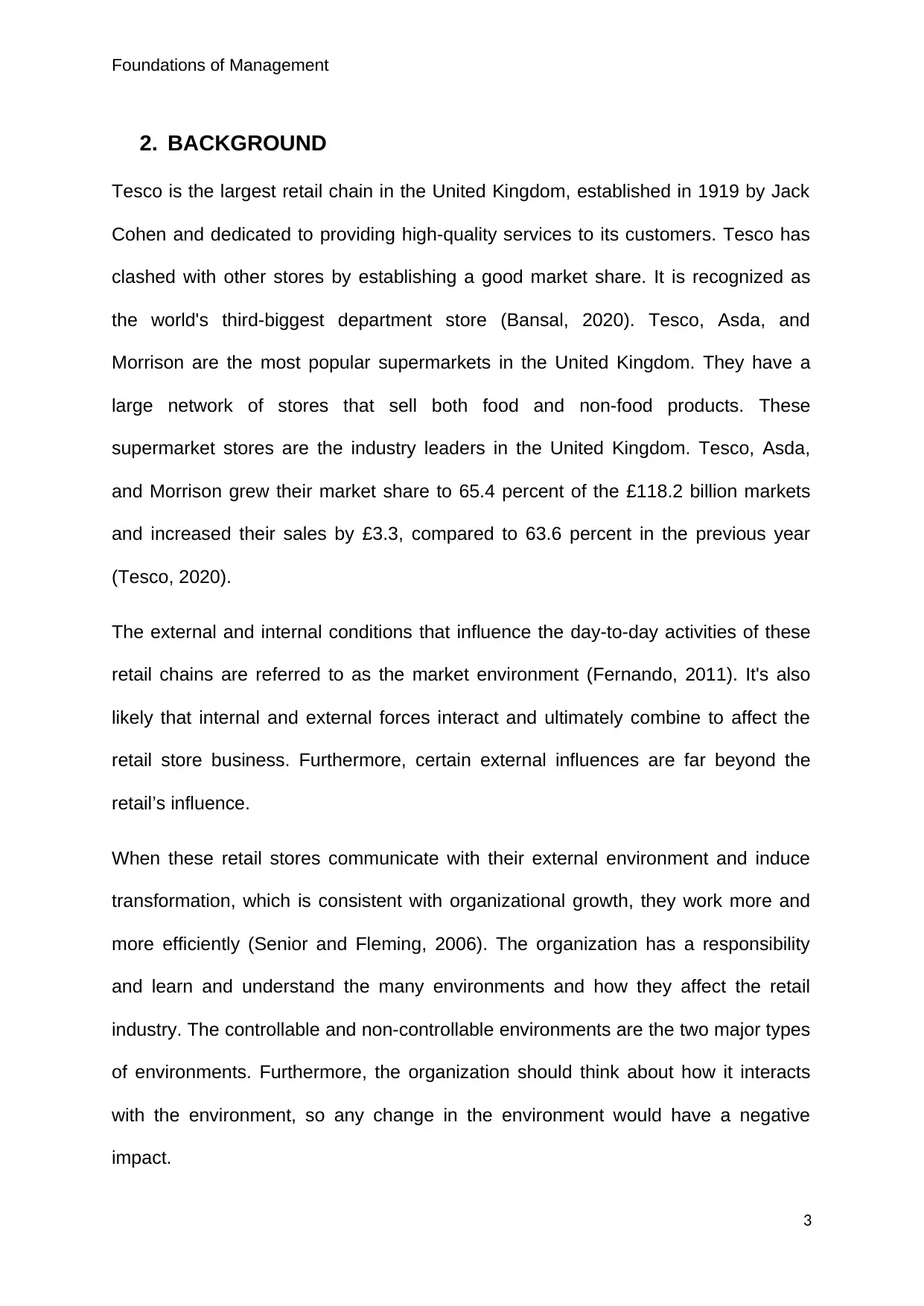
Foundations of Management
2. BACKGROUND
Tesco is the largest retail chain in the United Kingdom, established in 1919 by Jack
Cohen and dedicated to providing high-quality services to its customers. Tesco has
clashed with other stores by establishing a good market share. It is recognized as
the world's third-biggest department store (Bansal, 2020). Tesco, Asda, and
Morrison are the most popular supermarkets in the United Kingdom. They have a
large network of stores that sell both food and non-food products. These
supermarket stores are the industry leaders in the United Kingdom. Tesco, Asda,
and Morrison grew their market share to 65.4 percent of the £118.2 billion markets
and increased their sales by £3.3, compared to 63.6 percent in the previous year
(Tesco, 2020).
The external and internal conditions that influence the day-to-day activities of these
retail chains are referred to as the market environment (Fernando, 2011). It's also
likely that internal and external forces interact and ultimately combine to affect the
retail store business. Furthermore, certain external influences are far beyond the
retail’s influence.
When these retail stores communicate with their external environment and induce
transformation, which is consistent with organizational growth, they work more and
more efficiently (Senior and Fleming, 2006). The organization has a responsibility
and learn and understand the many environments and how they affect the retail
industry. The controllable and non-controllable environments are the two major types
of environments. Furthermore, the organization should think about how it interacts
with the environment, so any change in the environment would have a negative
impact.
3
2. BACKGROUND
Tesco is the largest retail chain in the United Kingdom, established in 1919 by Jack
Cohen and dedicated to providing high-quality services to its customers. Tesco has
clashed with other stores by establishing a good market share. It is recognized as
the world's third-biggest department store (Bansal, 2020). Tesco, Asda, and
Morrison are the most popular supermarkets in the United Kingdom. They have a
large network of stores that sell both food and non-food products. These
supermarket stores are the industry leaders in the United Kingdom. Tesco, Asda,
and Morrison grew their market share to 65.4 percent of the £118.2 billion markets
and increased their sales by £3.3, compared to 63.6 percent in the previous year
(Tesco, 2020).
The external and internal conditions that influence the day-to-day activities of these
retail chains are referred to as the market environment (Fernando, 2011). It's also
likely that internal and external forces interact and ultimately combine to affect the
retail store business. Furthermore, certain external influences are far beyond the
retail’s influence.
When these retail stores communicate with their external environment and induce
transformation, which is consistent with organizational growth, they work more and
more efficiently (Senior and Fleming, 2006). The organization has a responsibility
and learn and understand the many environments and how they affect the retail
industry. The controllable and non-controllable environments are the two major types
of environments. Furthermore, the organization should think about how it interacts
with the environment, so any change in the environment would have a negative
impact.
3
Paraphrase This Document
Need a fresh take? Get an instant paraphrase of this document with our AI Paraphraser
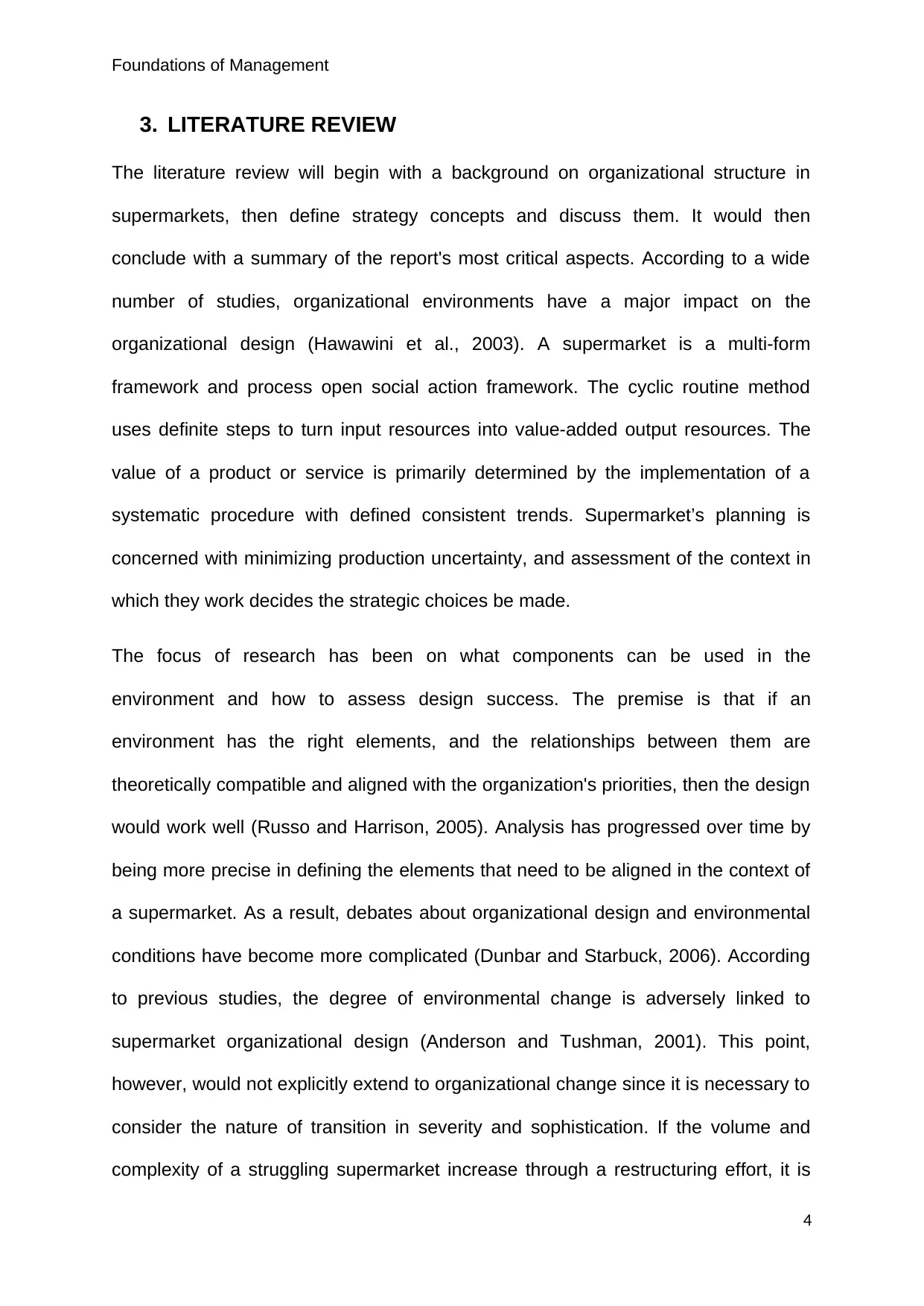
Foundations of Management
3. LITERATURE REVIEW
The literature review will begin with a background on organizational structure in
supermarkets, then define strategy concepts and discuss them. It would then
conclude with a summary of the report's most critical aspects. According to a wide
number of studies, organizational environments have a major impact on the
organizational design (Hawawini et al., 2003). A supermarket is a multi-form
framework and process open social action framework. The cyclic routine method
uses definite steps to turn input resources into value-added output resources. The
value of a product or service is primarily determined by the implementation of a
systematic procedure with defined consistent trends. Supermarket’s planning is
concerned with minimizing production uncertainty, and assessment of the context in
which they work decides the strategic choices be made.
The focus of research has been on what components can be used in the
environment and how to assess design success. The premise is that if an
environment has the right elements, and the relationships between them are
theoretically compatible and aligned with the organization's priorities, then the design
would work well (Russo and Harrison, 2005). Analysis has progressed over time by
being more precise in defining the elements that need to be aligned in the context of
a supermarket. As a result, debates about organizational design and environmental
conditions have become more complicated (Dunbar and Starbuck, 2006). According
to previous studies, the degree of environmental change is adversely linked to
supermarket organizational design (Anderson and Tushman, 2001). This point,
however, would not explicitly extend to organizational change since it is necessary to
consider the nature of transition in severity and sophistication. If the volume and
complexity of a struggling supermarket increase through a restructuring effort, it is
4
3. LITERATURE REVIEW
The literature review will begin with a background on organizational structure in
supermarkets, then define strategy concepts and discuss them. It would then
conclude with a summary of the report's most critical aspects. According to a wide
number of studies, organizational environments have a major impact on the
organizational design (Hawawini et al., 2003). A supermarket is a multi-form
framework and process open social action framework. The cyclic routine method
uses definite steps to turn input resources into value-added output resources. The
value of a product or service is primarily determined by the implementation of a
systematic procedure with defined consistent trends. Supermarket’s planning is
concerned with minimizing production uncertainty, and assessment of the context in
which they work decides the strategic choices be made.
The focus of research has been on what components can be used in the
environment and how to assess design success. The premise is that if an
environment has the right elements, and the relationships between them are
theoretically compatible and aligned with the organization's priorities, then the design
would work well (Russo and Harrison, 2005). Analysis has progressed over time by
being more precise in defining the elements that need to be aligned in the context of
a supermarket. As a result, debates about organizational design and environmental
conditions have become more complicated (Dunbar and Starbuck, 2006). According
to previous studies, the degree of environmental change is adversely linked to
supermarket organizational design (Anderson and Tushman, 2001). This point,
however, would not explicitly extend to organizational change since it is necessary to
consider the nature of transition in severity and sophistication. If the volume and
complexity of a struggling supermarket increase through a restructuring effort, it is
4
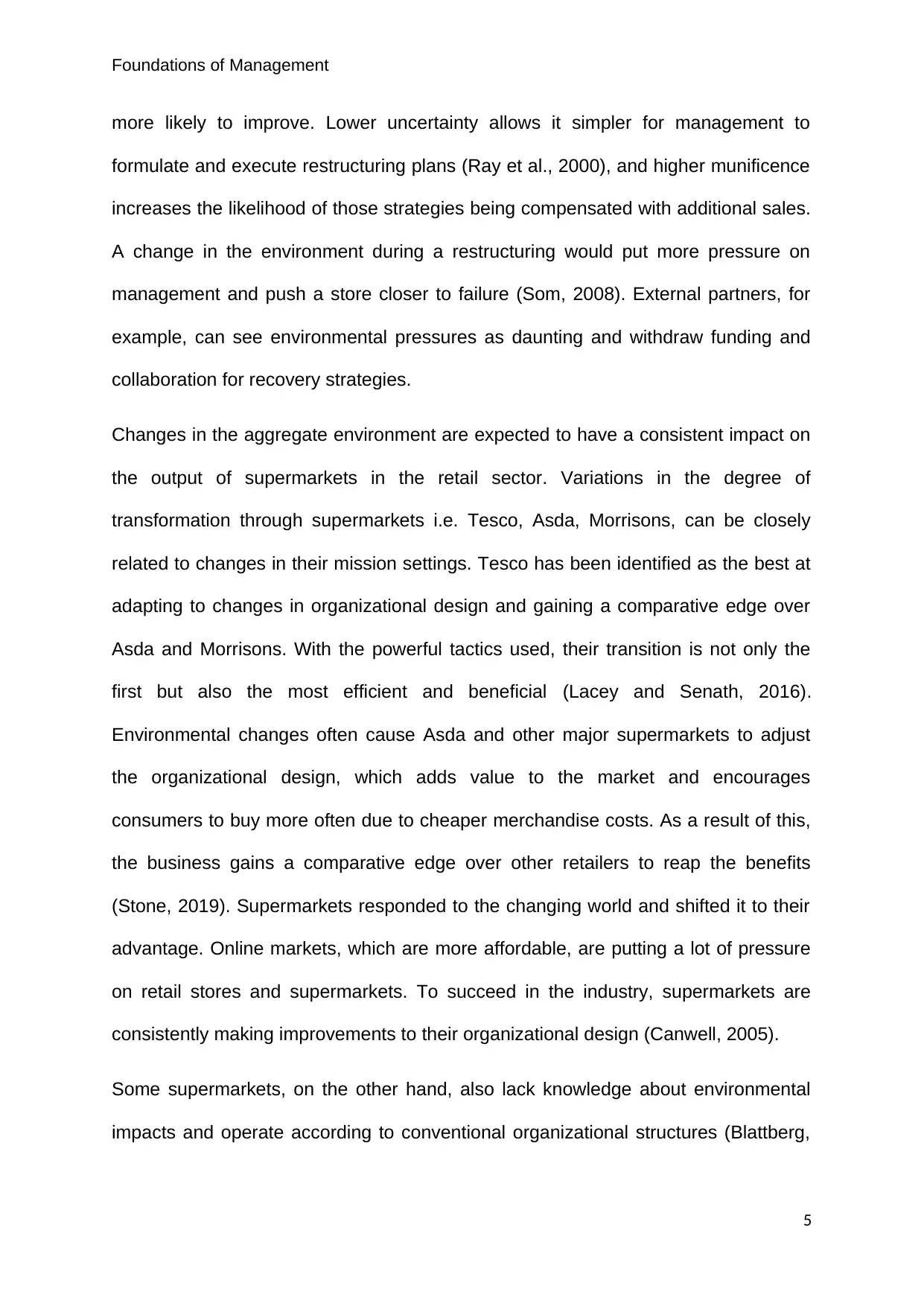
Foundations of Management
more likely to improve. Lower uncertainty allows it simpler for management to
formulate and execute restructuring plans (Ray et al., 2000), and higher munificence
increases the likelihood of those strategies being compensated with additional sales.
A change in the environment during a restructuring would put more pressure on
management and push a store closer to failure (Som, 2008). External partners, for
example, can see environmental pressures as daunting and withdraw funding and
collaboration for recovery strategies.
Changes in the aggregate environment are expected to have a consistent impact on
the output of supermarkets in the retail sector. Variations in the degree of
transformation through supermarkets i.e. Tesco, Asda, Morrisons, can be closely
related to changes in their mission settings. Tesco has been identified as the best at
adapting to changes in organizational design and gaining a comparative edge over
Asda and Morrisons. With the powerful tactics used, their transition is not only the
first but also the most efficient and beneficial (Lacey and Senath, 2016).
Environmental changes often cause Asda and other major supermarkets to adjust
the organizational design, which adds value to the market and encourages
consumers to buy more often due to cheaper merchandise costs. As a result of this,
the business gains a comparative edge over other retailers to reap the benefits
(Stone, 2019). Supermarkets responded to the changing world and shifted it to their
advantage. Online markets, which are more affordable, are putting a lot of pressure
on retail stores and supermarkets. To succeed in the industry, supermarkets are
consistently making improvements to their organizational design (Canwell, 2005).
Some supermarkets, on the other hand, also lack knowledge about environmental
impacts and operate according to conventional organizational structures (Blattberg,
5
more likely to improve. Lower uncertainty allows it simpler for management to
formulate and execute restructuring plans (Ray et al., 2000), and higher munificence
increases the likelihood of those strategies being compensated with additional sales.
A change in the environment during a restructuring would put more pressure on
management and push a store closer to failure (Som, 2008). External partners, for
example, can see environmental pressures as daunting and withdraw funding and
collaboration for recovery strategies.
Changes in the aggregate environment are expected to have a consistent impact on
the output of supermarkets in the retail sector. Variations in the degree of
transformation through supermarkets i.e. Tesco, Asda, Morrisons, can be closely
related to changes in their mission settings. Tesco has been identified as the best at
adapting to changes in organizational design and gaining a comparative edge over
Asda and Morrisons. With the powerful tactics used, their transition is not only the
first but also the most efficient and beneficial (Lacey and Senath, 2016).
Environmental changes often cause Asda and other major supermarkets to adjust
the organizational design, which adds value to the market and encourages
consumers to buy more often due to cheaper merchandise costs. As a result of this,
the business gains a comparative edge over other retailers to reap the benefits
(Stone, 2019). Supermarkets responded to the changing world and shifted it to their
advantage. Online markets, which are more affordable, are putting a lot of pressure
on retail stores and supermarkets. To succeed in the industry, supermarkets are
consistently making improvements to their organizational design (Canwell, 2005).
Some supermarkets, on the other hand, also lack knowledge about environmental
impacts and operate according to conventional organizational structures (Blattberg,
5
⊘ This is a preview!⊘
Do you want full access?
Subscribe today to unlock all pages.

Trusted by 1+ million students worldwide
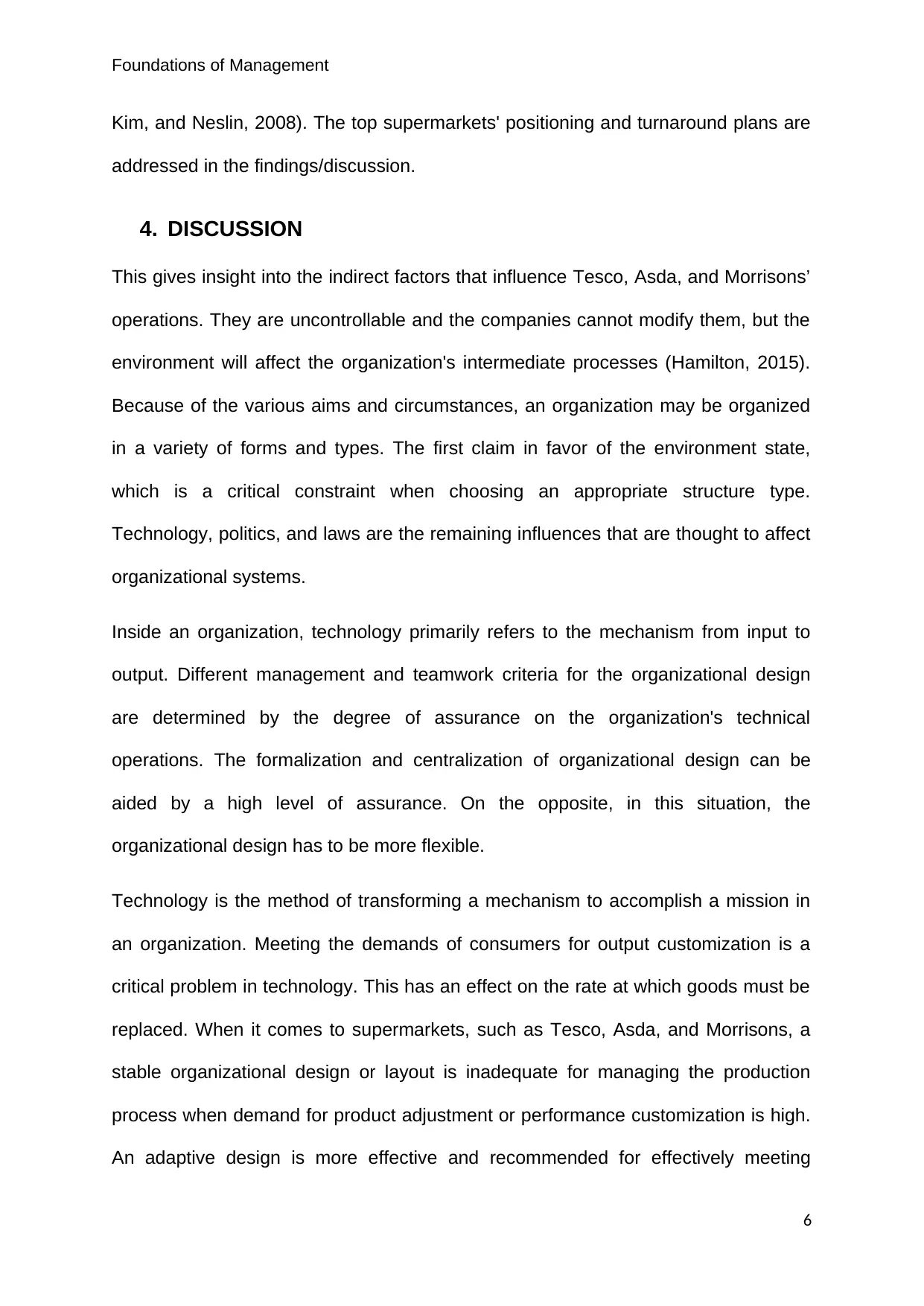
Foundations of Management
Kim, and Neslin, 2008). The top supermarkets' positioning and turnaround plans are
addressed in the findings/discussion.
4. DISCUSSION
This gives insight into the indirect factors that influence Tesco, Asda, and Morrisons’
operations. They are uncontrollable and the companies cannot modify them, but the
environment will affect the organization's intermediate processes (Hamilton, 2015).
Because of the various aims and circumstances, an organization may be organized
in a variety of forms and types. The first claim in favor of the environment state,
which is a critical constraint when choosing an appropriate structure type.
Technology, politics, and laws are the remaining influences that are thought to affect
organizational systems.
Inside an organization, technology primarily refers to the mechanism from input to
output. Different management and teamwork criteria for the organizational design
are determined by the degree of assurance on the organization's technical
operations. The formalization and centralization of organizational design can be
aided by a high level of assurance. On the opposite, in this situation, the
organizational design has to be more flexible.
Technology is the method of transforming a mechanism to accomplish a mission in
an organization. Meeting the demands of consumers for output customization is a
critical problem in technology. This has an effect on the rate at which goods must be
replaced. When it comes to supermarkets, such as Tesco, Asda, and Morrisons, a
stable organizational design or layout is inadequate for managing the production
process when demand for product adjustment or performance customization is high.
An adaptive design is more effective and recommended for effectively meeting
6
Kim, and Neslin, 2008). The top supermarkets' positioning and turnaround plans are
addressed in the findings/discussion.
4. DISCUSSION
This gives insight into the indirect factors that influence Tesco, Asda, and Morrisons’
operations. They are uncontrollable and the companies cannot modify them, but the
environment will affect the organization's intermediate processes (Hamilton, 2015).
Because of the various aims and circumstances, an organization may be organized
in a variety of forms and types. The first claim in favor of the environment state,
which is a critical constraint when choosing an appropriate structure type.
Technology, politics, and laws are the remaining influences that are thought to affect
organizational systems.
Inside an organization, technology primarily refers to the mechanism from input to
output. Different management and teamwork criteria for the organizational design
are determined by the degree of assurance on the organization's technical
operations. The formalization and centralization of organizational design can be
aided by a high level of assurance. On the opposite, in this situation, the
organizational design has to be more flexible.
Technology is the method of transforming a mechanism to accomplish a mission in
an organization. Meeting the demands of consumers for output customization is a
critical problem in technology. This has an effect on the rate at which goods must be
replaced. When it comes to supermarkets, such as Tesco, Asda, and Morrisons, a
stable organizational design or layout is inadequate for managing the production
process when demand for product adjustment or performance customization is high.
An adaptive design is more effective and recommended for effectively meeting
6
Paraphrase This Document
Need a fresh take? Get an instant paraphrase of this document with our AI Paraphraser
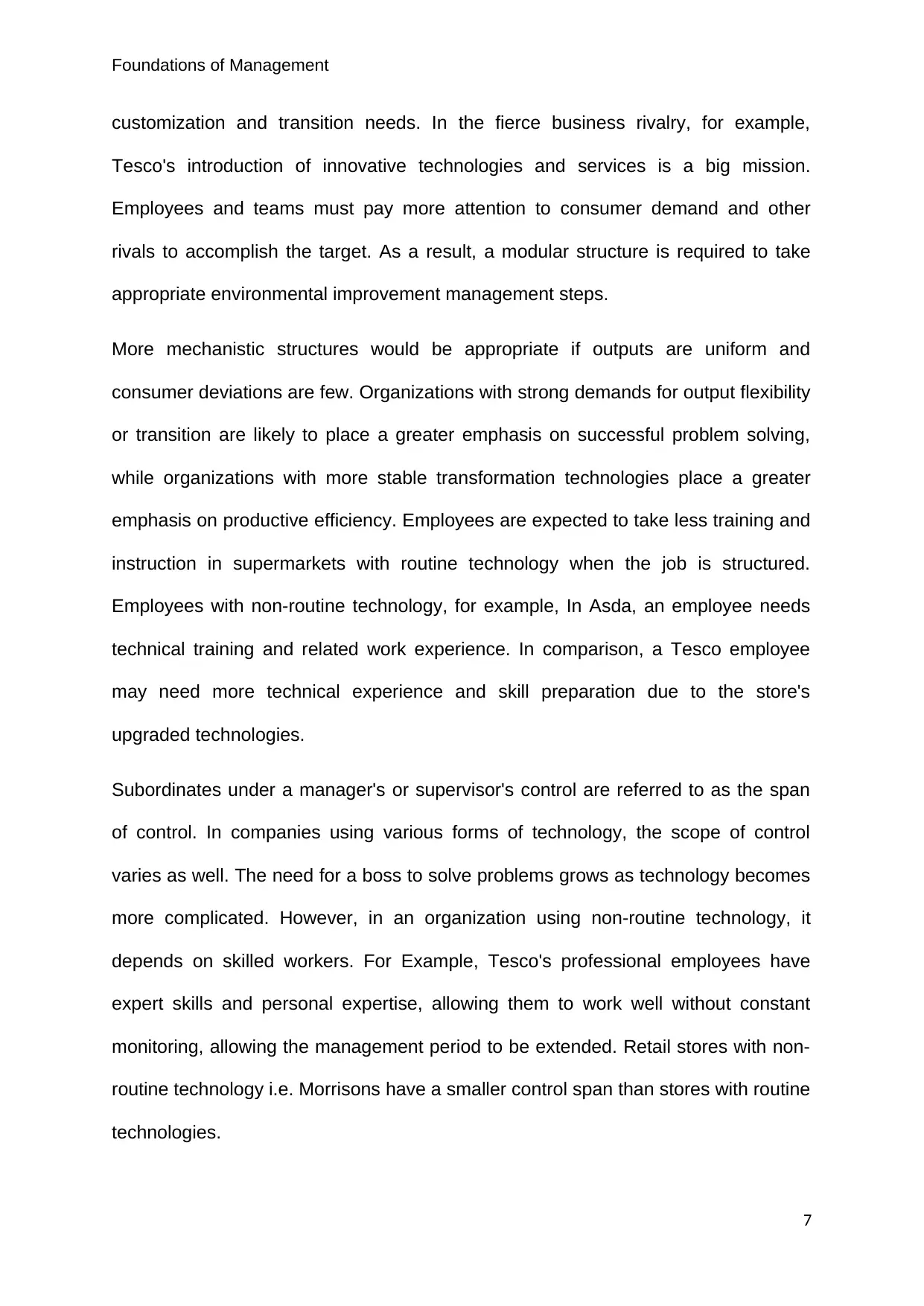
Foundations of Management
customization and transition needs. In the fierce business rivalry, for example,
Tesco's introduction of innovative technologies and services is a big mission.
Employees and teams must pay more attention to consumer demand and other
rivals to accomplish the target. As a result, a modular structure is required to take
appropriate environmental improvement management steps.
More mechanistic structures would be appropriate if outputs are uniform and
consumer deviations are few. Organizations with strong demands for output flexibility
or transition are likely to place a greater emphasis on successful problem solving,
while organizations with more stable transformation technologies place a greater
emphasis on productive efficiency. Employees are expected to take less training and
instruction in supermarkets with routine technology when the job is structured.
Employees with non-routine technology, for example, In Asda, an employee needs
technical training and related work experience. In comparison, a Tesco employee
may need more technical experience and skill preparation due to the store's
upgraded technologies.
Subordinates under a manager's or supervisor's control are referred to as the span
of control. In companies using various forms of technology, the scope of control
varies as well. The need for a boss to solve problems grows as technology becomes
more complicated. However, in an organization using non-routine technology, it
depends on skilled workers. For Example, Tesco's professional employees have
expert skills and personal expertise, allowing them to work well without constant
monitoring, allowing the management period to be extended. Retail stores with non-
routine technology i.e. Morrisons have a smaller control span than stores with routine
technologies.
7
customization and transition needs. In the fierce business rivalry, for example,
Tesco's introduction of innovative technologies and services is a big mission.
Employees and teams must pay more attention to consumer demand and other
rivals to accomplish the target. As a result, a modular structure is required to take
appropriate environmental improvement management steps.
More mechanistic structures would be appropriate if outputs are uniform and
consumer deviations are few. Organizations with strong demands for output flexibility
or transition are likely to place a greater emphasis on successful problem solving,
while organizations with more stable transformation technologies place a greater
emphasis on productive efficiency. Employees are expected to take less training and
instruction in supermarkets with routine technology when the job is structured.
Employees with non-routine technology, for example, In Asda, an employee needs
technical training and related work experience. In comparison, a Tesco employee
may need more technical experience and skill preparation due to the store's
upgraded technologies.
Subordinates under a manager's or supervisor's control are referred to as the span
of control. In companies using various forms of technology, the scope of control
varies as well. The need for a boss to solve problems grows as technology becomes
more complicated. However, in an organization using non-routine technology, it
depends on skilled workers. For Example, Tesco's professional employees have
expert skills and personal expertise, allowing them to work well without constant
monitoring, allowing the management period to be extended. Retail stores with non-
routine technology i.e. Morrisons have a smaller control span than stores with routine
technologies.
7
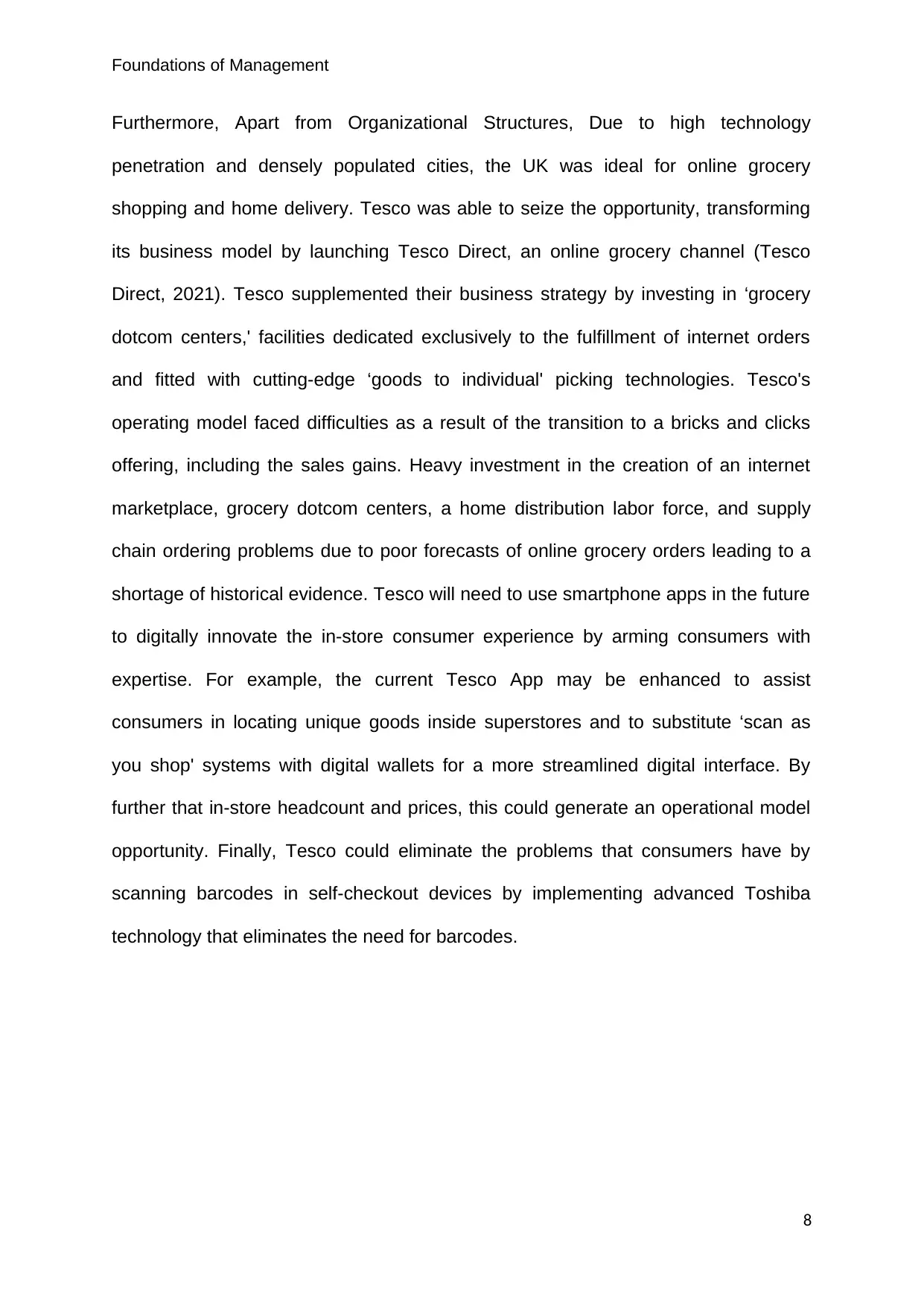
Foundations of Management
Furthermore, Apart from Organizational Structures, Due to high technology
penetration and densely populated cities, the UK was ideal for online grocery
shopping and home delivery. Tesco was able to seize the opportunity, transforming
its business model by launching Tesco Direct, an online grocery channel (Tesco
Direct, 2021). Tesco supplemented their business strategy by investing in ‘grocery
dotcom centers,' facilities dedicated exclusively to the fulfillment of internet orders
and fitted with cutting-edge ‘goods to individual' picking technologies. Tesco's
operating model faced difficulties as a result of the transition to a bricks and clicks
offering, including the sales gains. Heavy investment in the creation of an internet
marketplace, grocery dotcom centers, a home distribution labor force, and supply
chain ordering problems due to poor forecasts of online grocery orders leading to a
shortage of historical evidence. Tesco will need to use smartphone apps in the future
to digitally innovate the in-store consumer experience by arming consumers with
expertise. For example, the current Tesco App may be enhanced to assist
consumers in locating unique goods inside superstores and to substitute ‘scan as
you shop' systems with digital wallets for a more streamlined digital interface. By
further that in-store headcount and prices, this could generate an operational model
opportunity. Finally, Tesco could eliminate the problems that consumers have by
scanning barcodes in self-checkout devices by implementing advanced Toshiba
technology that eliminates the need for barcodes.
8
Furthermore, Apart from Organizational Structures, Due to high technology
penetration and densely populated cities, the UK was ideal for online grocery
shopping and home delivery. Tesco was able to seize the opportunity, transforming
its business model by launching Tesco Direct, an online grocery channel (Tesco
Direct, 2021). Tesco supplemented their business strategy by investing in ‘grocery
dotcom centers,' facilities dedicated exclusively to the fulfillment of internet orders
and fitted with cutting-edge ‘goods to individual' picking technologies. Tesco's
operating model faced difficulties as a result of the transition to a bricks and clicks
offering, including the sales gains. Heavy investment in the creation of an internet
marketplace, grocery dotcom centers, a home distribution labor force, and supply
chain ordering problems due to poor forecasts of online grocery orders leading to a
shortage of historical evidence. Tesco will need to use smartphone apps in the future
to digitally innovate the in-store consumer experience by arming consumers with
expertise. For example, the current Tesco App may be enhanced to assist
consumers in locating unique goods inside superstores and to substitute ‘scan as
you shop' systems with digital wallets for a more streamlined digital interface. By
further that in-store headcount and prices, this could generate an operational model
opportunity. Finally, Tesco could eliminate the problems that consumers have by
scanning barcodes in self-checkout devices by implementing advanced Toshiba
technology that eliminates the need for barcodes.
8
⊘ This is a preview!⊘
Do you want full access?
Subscribe today to unlock all pages.

Trusted by 1+ million students worldwide
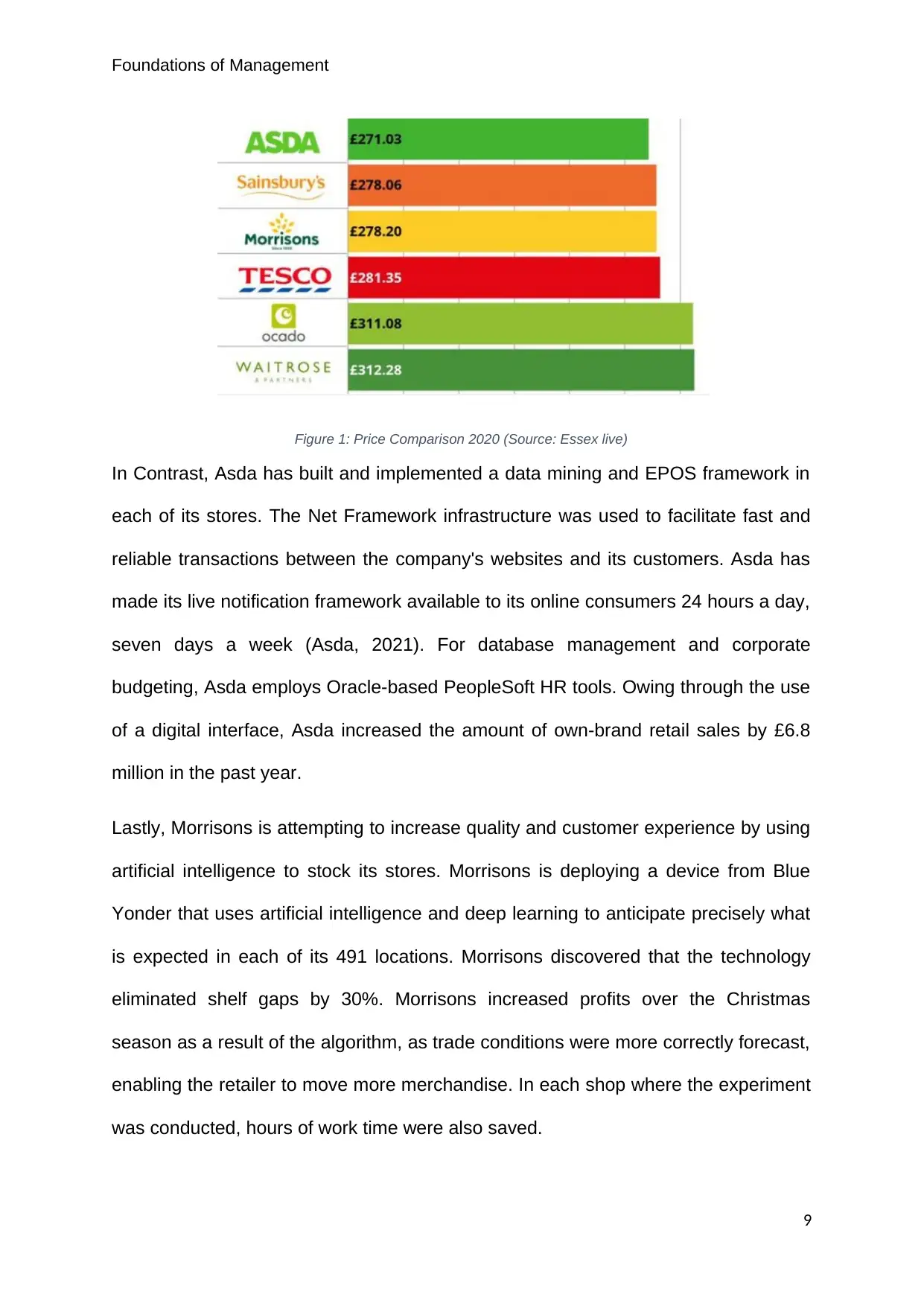
Foundations of Management
Figure 1: Price Comparison 2020 (Source: Essex live)
In Contrast, Asda has built and implemented a data mining and EPOS framework in
each of its stores. The Net Framework infrastructure was used to facilitate fast and
reliable transactions between the company's websites and its customers. Asda has
made its live notification framework available to its online consumers 24 hours a day,
seven days a week (Asda, 2021). For database management and corporate
budgeting, Asda employs Oracle-based PeopleSoft HR tools. Owing through the use
of a digital interface, Asda increased the amount of own-brand retail sales by £6.8
million in the past year.
Lastly, Morrisons is attempting to increase quality and customer experience by using
artificial intelligence to stock its stores. Morrisons is deploying a device from Blue
Yonder that uses artificial intelligence and deep learning to anticipate precisely what
is expected in each of its 491 locations. Morrisons discovered that the technology
eliminated shelf gaps by 30%. Morrisons increased profits over the Christmas
season as a result of the algorithm, as trade conditions were more correctly forecast,
enabling the retailer to move more merchandise. In each shop where the experiment
was conducted, hours of work time were also saved.
9
Figure 1: Price Comparison 2020 (Source: Essex live)
In Contrast, Asda has built and implemented a data mining and EPOS framework in
each of its stores. The Net Framework infrastructure was used to facilitate fast and
reliable transactions between the company's websites and its customers. Asda has
made its live notification framework available to its online consumers 24 hours a day,
seven days a week (Asda, 2021). For database management and corporate
budgeting, Asda employs Oracle-based PeopleSoft HR tools. Owing through the use
of a digital interface, Asda increased the amount of own-brand retail sales by £6.8
million in the past year.
Lastly, Morrisons is attempting to increase quality and customer experience by using
artificial intelligence to stock its stores. Morrisons is deploying a device from Blue
Yonder that uses artificial intelligence and deep learning to anticipate precisely what
is expected in each of its 491 locations. Morrisons discovered that the technology
eliminated shelf gaps by 30%. Morrisons increased profits over the Christmas
season as a result of the algorithm, as trade conditions were more correctly forecast,
enabling the retailer to move more merchandise. In each shop where the experiment
was conducted, hours of work time were also saved.
9
Paraphrase This Document
Need a fresh take? Get an instant paraphrase of this document with our AI Paraphraser
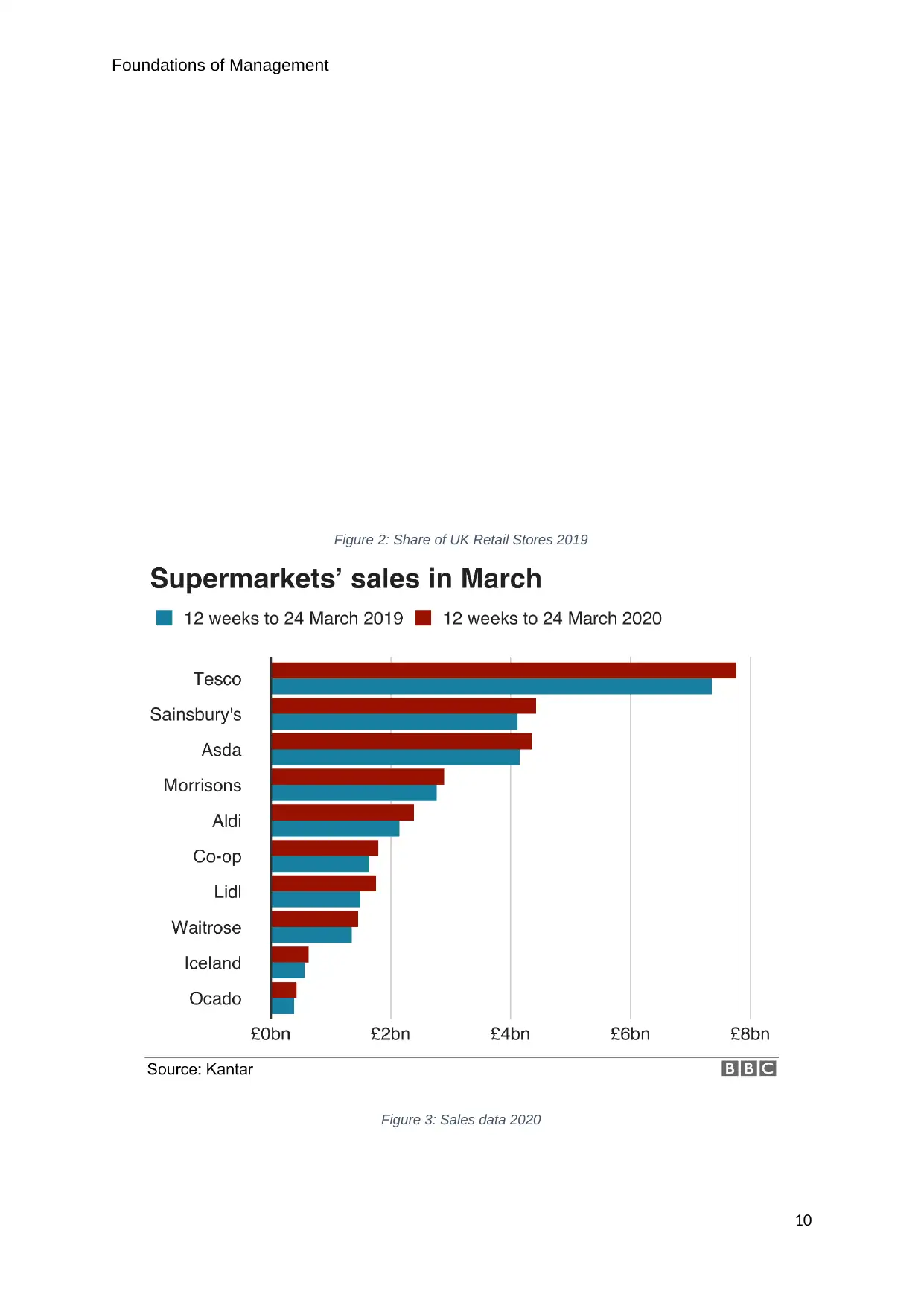
Foundations of Management
Figure 2: Share of UK Retail Stores 2019
Figure 3: Sales data 2020
10
Figure 2: Share of UK Retail Stores 2019
Figure 3: Sales data 2020
10
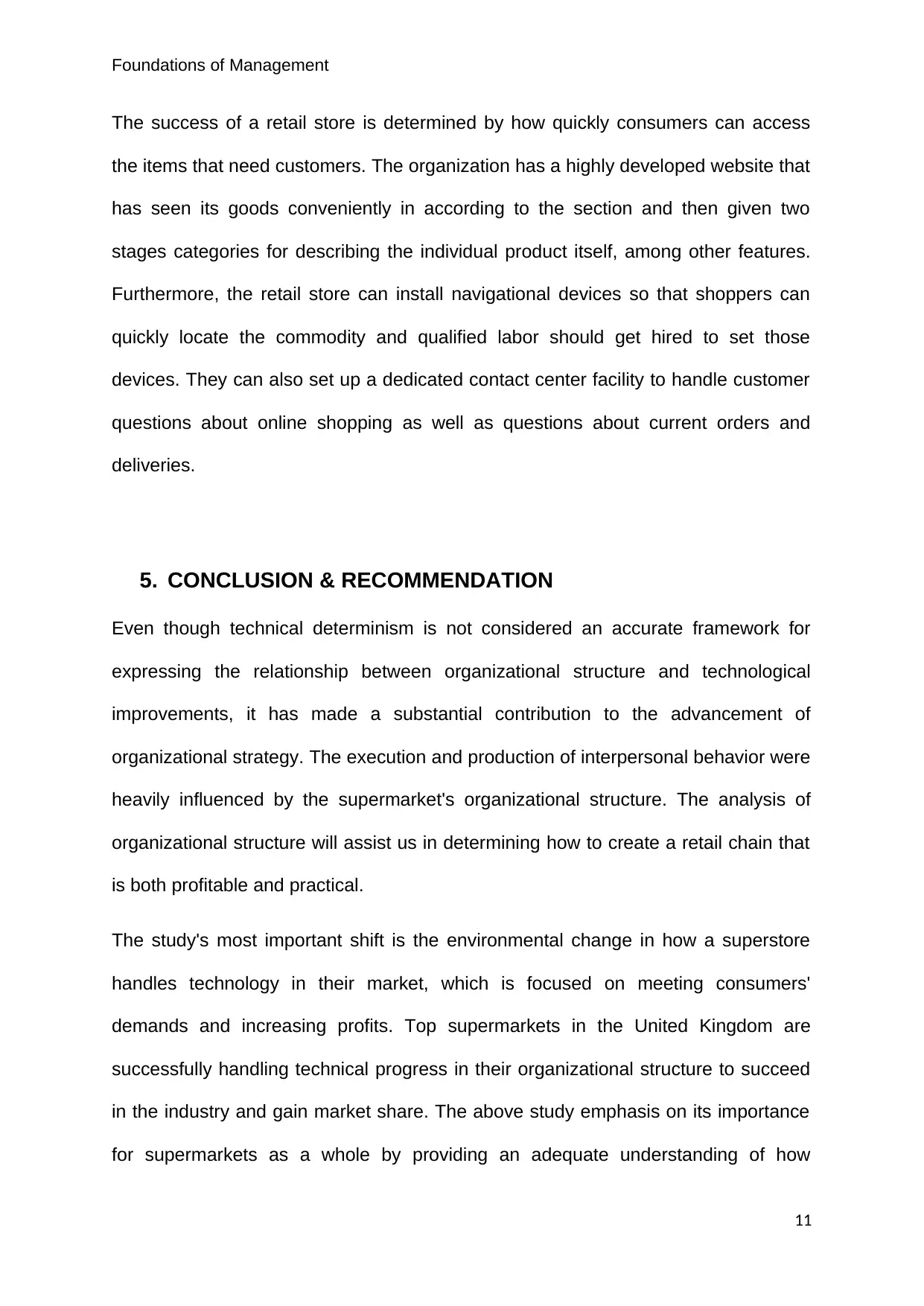
Foundations of Management
The success of a retail store is determined by how quickly consumers can access
the items that need customers. The organization has a highly developed website that
has seen its goods conveniently in according to the section and then given two
stages categories for describing the individual product itself, among other features.
Furthermore, the retail store can install navigational devices so that shoppers can
quickly locate the commodity and qualified labor should get hired to set those
devices. They can also set up a dedicated contact center facility to handle customer
questions about online shopping as well as questions about current orders and
deliveries.
5. CONCLUSION & RECOMMENDATION
Even though technical determinism is not considered an accurate framework for
expressing the relationship between organizational structure and technological
improvements, it has made a substantial contribution to the advancement of
organizational strategy. The execution and production of interpersonal behavior were
heavily influenced by the supermarket's organizational structure. The analysis of
organizational structure will assist us in determining how to create a retail chain that
is both profitable and practical.
The study's most important shift is the environmental change in how a superstore
handles technology in their market, which is focused on meeting consumers'
demands and increasing profits. Top supermarkets in the United Kingdom are
successfully handling technical progress in their organizational structure to succeed
in the industry and gain market share. The above study emphasis on its importance
for supermarkets as a whole by providing an adequate understanding of how
11
The success of a retail store is determined by how quickly consumers can access
the items that need customers. The organization has a highly developed website that
has seen its goods conveniently in according to the section and then given two
stages categories for describing the individual product itself, among other features.
Furthermore, the retail store can install navigational devices so that shoppers can
quickly locate the commodity and qualified labor should get hired to set those
devices. They can also set up a dedicated contact center facility to handle customer
questions about online shopping as well as questions about current orders and
deliveries.
5. CONCLUSION & RECOMMENDATION
Even though technical determinism is not considered an accurate framework for
expressing the relationship between organizational structure and technological
improvements, it has made a substantial contribution to the advancement of
organizational strategy. The execution and production of interpersonal behavior were
heavily influenced by the supermarket's organizational structure. The analysis of
organizational structure will assist us in determining how to create a retail chain that
is both profitable and practical.
The study's most important shift is the environmental change in how a superstore
handles technology in their market, which is focused on meeting consumers'
demands and increasing profits. Top supermarkets in the United Kingdom are
successfully handling technical progress in their organizational structure to succeed
in the industry and gain market share. The above study emphasis on its importance
for supermarkets as a whole by providing an adequate understanding of how
11
⊘ This is a preview!⊘
Do you want full access?
Subscribe today to unlock all pages.

Trusted by 1+ million students worldwide
1 out of 15
Related Documents
Your All-in-One AI-Powered Toolkit for Academic Success.
+13062052269
info@desklib.com
Available 24*7 on WhatsApp / Email
![[object Object]](/_next/static/media/star-bottom.7253800d.svg)
Unlock your academic potential
Copyright © 2020–2025 A2Z Services. All Rights Reserved. Developed and managed by ZUCOL.




